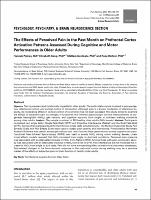Please use this identifier to cite or link to this item:
https://hdl.handle.net/20.500.12202/9372| Title: | The effects of perceived pain in the past month on prefrontal cortex activation patterns assessed during cognitive and motor performances in older adults. |
| Authors: | Holtzer, Roee Pakray, Hannah Izzetoglu, Meltem Seng, Elizabeth 0000-0001-6639-0724 0000-0002-8938-4949 Elizabeth Seng |
| Keywords: | Pain Medicine Cognitive Function hyperbaric oxygenation pain prefrontal cortex (PFC) older adult |
| Issue Date: | Feb-2021 |
| Publisher: | Oxford Academic |
| Citation: | Pakray, H., Seng, E., Izzetoglu,M., & Holtzer, R. (2021). The effects of perceived pain in the past month on prefrontal cortex activation patterns assessed during cognitive and motor performances in older adults.. Pain Medicine (Malden, Mass.), 22(2), 303–314. https://doi.org/10.1093/pm/pnaa404 |
| Series/Report no.: | Pain Medicine;22(2) |
| Abstract: | _Abstract_ _Objective_ Pain is prevalent and functionally impactful in older adults. The prefrontal cortex is involved in pain perception, attentional control, and cortical control of locomotion. Although pain is a known moderator of attentional capacity, its moderating effect on cortical control of locomotion has not been assessed. This study aimed to examine the effects of subjective pain on changes in functional near-infrared spectroscopy–derived measurements of oxygenated hemoglobin (HbO2), gait velocity, and cognitive accuracy from single- to dual-task walking conditions among older adults. _Subjects_ The sample consisted of 383 healthy older adults (55% female). _Methods_ Participants completed two single tasks (Single-Task-Walk [STW] and Cognitive Interference [Alpha]) and the Dual-Task-Walk (DTW), during which participants performed the two single tasks simultaneously. The Medical Outcomes Study Pain Severity Scale and Pain Effects Scale were used to assess pain severity and interference. ProtoKinetics Movement Analysis Software was used to assess gait velocity and rate of correct letter generation to assess cognitive accuracy. Functional Near-Infrared Spectroscopy (fNIRS) was used to assess HbO2 during active walking. _Results_ Linear mixed-effects models revealed that HbO2 increased from single- to dual-task conditions. Perceived pain presence was associated with an attenuated increase in HbO2 from Alpha to DTW. Among those with pain, worse pain severity was associated with an attenuated increase in HbO2 from STW to DTW. Pain interference did not moderate the increase in HbO2 from single to dual tasks. Pain did not have a moderating effect on behavioral outcomes. _Conclusions_ Task-related changes in the hemodynamic response in the prefrontal cortex during walking may be a sensitive marker of the effects of subjective pain on brain function in healthy older adults. |
| Description: | Scholarly article / Open access |
| URI: | https://academic.oup.com/painmedicine/article/22/2/303/6015930 https://hdl.handle.net/20.500.12202/9372 |
| ISSN: | 1526-4637. |
| Appears in Collections: | Ferkauf Graduate School of Psychology: Faculty Publications |
Files in This Item:
| File | Description | Size | Format | |
|---|---|---|---|---|
| Holtzer 2021 OA The effects of perceived pnaa404.pdf | 197.81 kB | Adobe PDF |  View/Open |
This item is licensed under a Creative Commons License

